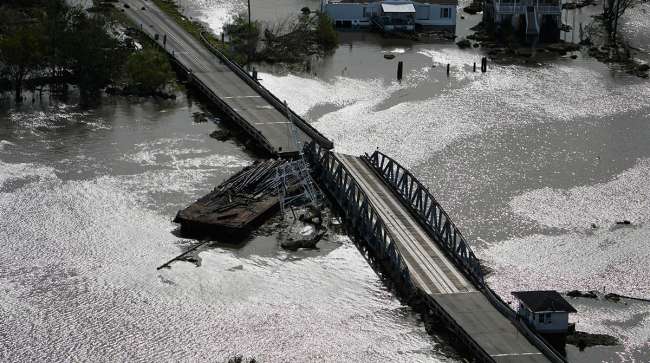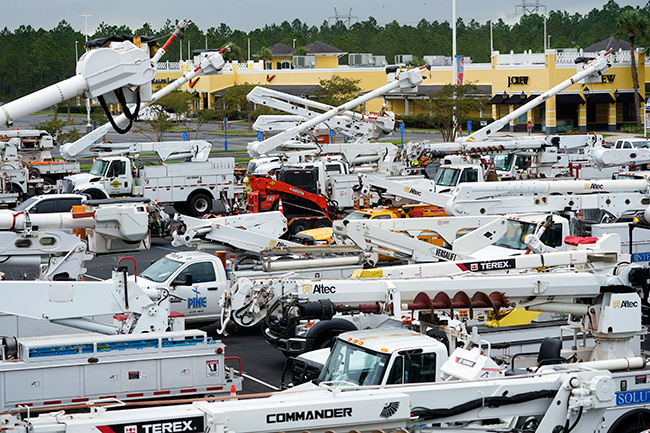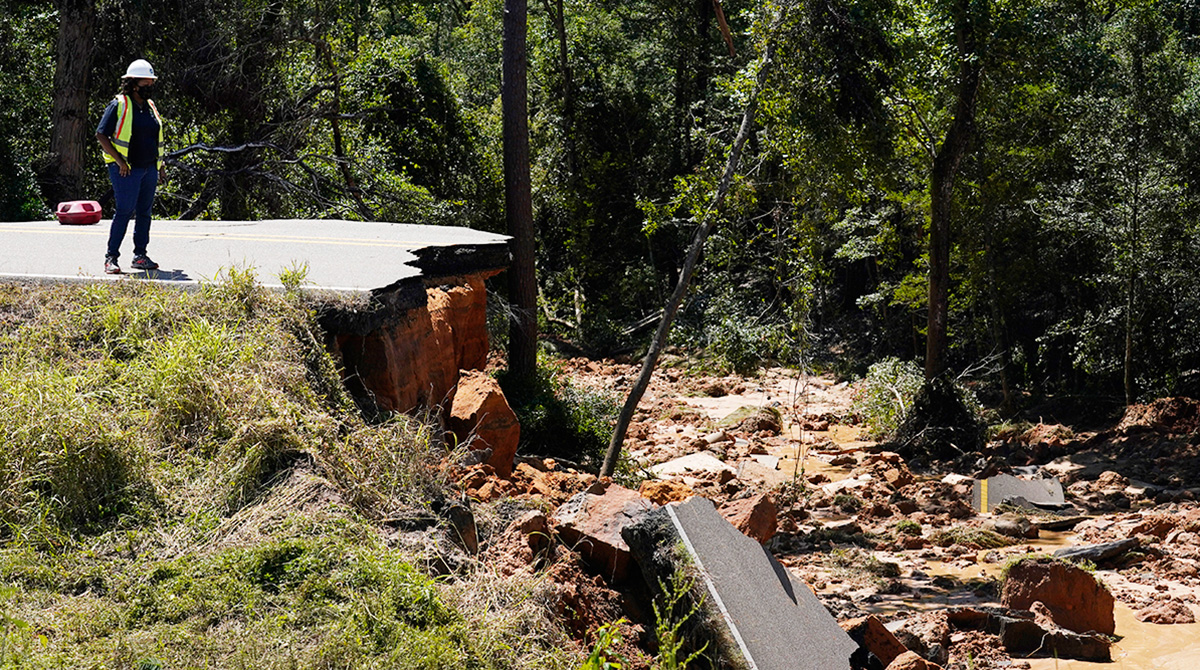Staff Reporter
Truckers Face Outages, Road Closures and Fuel Supply Challenges in Ida’s Wake

[Stay on top of transportation news: Get TTNews in your inbox.]
Trucking companies are contending with obstructed routes, power outages and fuel supply challenges in the wake of Hurricane Ida.
The Category 4 storm made landfall Aug. 29, slamming Louisiana with winds reaching 150 mph and flooding the Gulf Coast as one of the strongest hurricanes on record to hit the United States. Remnants of it moved up the East Coast, dropping a record amount of rain in New York City that left destruction and death.
The National Hurricane Center said Sept. 2 that the storm was still moving northeast.

Utility trucks stage in a parking lot as they prepare to repair damage to the power grid on Aug. 30 in Gulfport, Miss. (Steve Helber/AP)
The Gulf Coast, however, took the brunt of Hurricane Ida’s blow.
Crews continue to clear roadways of debris, ranging from trees to power lines.
“The fact that we have such a huge, massive lack of power in the state has really impacted a lot of the trucking industry, especially if you operate around the city of New Orleans,” Louisiana Motor Transport Association Executive Director Renee Amar told Transport Topics.
Many routes are still waterlogged.
Mississippi’s state Route 26 in George County is closed due to a road washout that killed two people. The route, which is in a rural area, is used by trucks, said Mississippi Trucking Association President Hal Miller.

An official looks at the deep hole on Mississippi Highway 26 in the Crossroads community. (Rogelio V. Solis/Associated Press)
George County is in southeast Mississippi, about 40 miles north of the Gulf of Mexico.
In Louisiana, Interstate 10, a major freight corridor for the state, is open — although dozens of roadways in the New Orleans area remain blocked.
“Those people that are operating are going to have to figure out alternate routes,” Amar said. “Sometimes that’s going to be a local highway. Some of those streets may not be conducive to 18-wheelers driving on [them].”
Interstate 10 stretches from Santa Monica, Calif., to Jacksonville, Fla.
One of the most significant challenges from Ida was the havoc wreaked on the electrical system, Amar said. Ida’s winds toppled a transmission tower and downed power lines, causing widespread outages.
Amar said a lot of trucking firms have backup generators, which have helped their companies function. But in some cases, the generators aren’t a perfect fix.
One of Amar’s members based in Gramercy sustained his business operations with generators, but lacked internet connectivity. The member ran his company Aug. 31 from a conference room at the association’s office, Amar said.
The lack of electricity is also hampering a fuel market that has already been strained by people leaving Louisiana to escape Hurricane Ida’s path.
Dupré Logistics estimated its dedicated truck and fuel operations had 50-60 customers offline as of Sept. 1. Drivers can deliver fuel without electricity, but the stations need electricity to pump the fuel.
Working with @La_DOTD our engineer work teams are actively engaged throughout 11 parishes and have assessed 2,112 miles and cleared 403 miles of roadway from Hurricane #Ida. #ProtectWhatMatters @GOHSEP pic.twitter.com/KZ0qT9jnsc — LA National Guard (@LANationalGuard) September 1, 2021
Based in Lafayette, La., Dupré provides transportation and logistics services, including energy and chemical transport, site logistics and freight brokerage.
“We are currently being directed by customers on where to deliver — stations that have been assessed and have power or will be getting power via generator,” said Tony Becnel, director of operations for energy distribution services at Dupré.
The company ranks No. 90 on the Transport Topics Top 100 list of the largest for-hire carriers in North America.
Miller said the fuel challenges in Louisiana have created a ripple effect in Mississippi. He said people have been coming into Mississippi from Louisiana to fuel up their vehicles, placing a strain on haulers.
“Particularly in the southwest corner, there’s really a challenge there to keep the stations fueled up,” Miller told TT. “There’s only so many trucks and drivers. They’re doing all they can do. It’s just a huge demand in a very small geographical area.”
As leaders determine steps for recovery, federal and state agencies have issued declarations to assist with relief efforts.
FMCSA has issued a Emergency Declaration for AL, AR, LA, MS, TN,, TX in response to Hurricane Ida. This grants temporary relief for drivers and carriers providing direct emergency response transporting supplies, goods, equipment, fuel and persons. See: https://t.co/JMR27sr0Xa pic.twitter.com/HwH9ffBUow — FMCSA (@FMCSA) August 29, 2021
The Federal Motor Carrier Safety Administration on Aug. 29 issued a regional emergency declaration relieving maximum driving time provisions for property-carrying vehicles and passenger-carrying vehicles. The declaration encompasses Alabama, Arkansas, Louisiana, Mississippi, Tennessee and Texas and applies to drivers who are providing direct assistance in support of emergency relief efforts.
On Aug. 30, Kentucky Transportation Cabinet Secretary Jim Gray signed an order temporarily suspending certain restrictions for commercial drivers engaged in restoring power and removing debris in areas affected by the storm.
“I’m sure they appreciate some of that relief,” Kentucky Trucking Association President Rick Taylor told TT. “If the carrier’s not comfortable with the relief, they obviously don’t have to use it.”
Want more news? Listen to today's daily briefing below or go here for more info:

